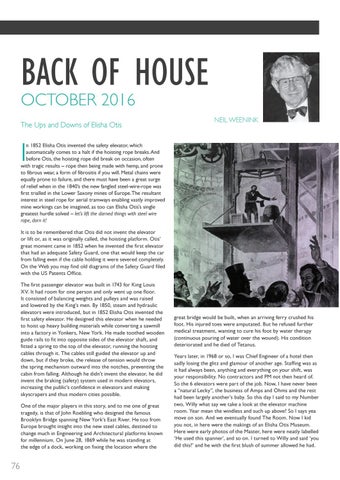BACK OF HOUSE OCTOBER 2016 The Ups and Downs of Elisha Otis
NEIL WEENINK
I
n 1852 Elisha Otis invented the safety elevator, which automatically comes to a halt if the hoisting rope breaks. And before Otis, the hoisting rope did break on occasion, often with tragic results – rope then being made with hemp, and prone to fibrous wear, a form of fibrositis if you will. Metal chains were equally prone to failure, and there must have been a great surge of relief when in the 1840’s the new fangled steel-wire-rope was first trialled in the Lower Saxony mines of Europe. The resultant interest in steel rope for aerial tramways enabling vastly improved mine workings can be imagined, as too can Elisha Otis’s single greatest hurdle solved – let’s lift the darned things with steel wire rope, darn it! It is to be remembered that Otis did not invent the elevator or lift or, as it was originally called, the hoisting platform. Otis’ great moment came in 1852 when he invented the first elevator that had an adequate Safety Guard, one that would keep the car from falling even if the cable holding it were severed completely. On the Web you may find old diagrams of the Safety Guard filed with the US Patents Office. The first passenger elevator was built in 1743 for King Louis XV. It had room for one person and only went up one floor. It consisted of balancing weights and pulleys and was raised and lowered by the King’s men. By 1850, steam and hydraulic elevators were introduced, but in 1852 Elisha Otis invented the first safety elevator. He designed this elevator when he needed to hoist up heavy building materials while converting a sawmill into a factory in Yonkers, New York. He made toothed wooden guide rails to fit into opposite sides of the elevator shaft, and fitted a spring to the top of the elevator, running the hoisting cables through it. The cables still guided the elevator up and down, but if they broke, the release of tension would throw the spring mechanism outward into the notches, preventing the cabin from falling. Although he didn’t invent the elevator, he did invent the braking (safety) system used in modern elevators, increasing the public’s confidence in elevators and making skyscrapers and thus modern cities possible. One of the major players in this story, and to me one of great tragedy, is that of John Roebling who designed the famous Brooklyn Bridge spanning New York’s East River. He too from Europe brought insight into the new steel cables, destined to change much in Engineering and Architectural platforms known for millennium. On June 28, 1869 while he was standing at the edge of a dock, working on fixing the location where the
76
great bridge would be built, when an arriving ferry crushed his foot. His injured toes were amputated. But he refused further medical treatment, wanting to cure his foot by water therapy (continuous pouring of water over the wound). His condition deteriorated and he died of Tetanus. Years later, in 1968 or so, I was Chief Engineer of a hotel then sadly losing the glitz and glamour of another age. Staffing was as it had always been, anything and everything on your shift, was your responsibility. No contractors and PM not then heard of. So the 6 elevators were part of the job. Now, I have never been a “natural Lecky”, the business of Amps and Ohms and the rest had been largely another’s baby. So this day I said to my Number two, Willy what say we take a look at the elevator machine room. Year mean the windless and such up above? So I says yea move on son. And we eventually found The Room. Now I kid you not, in here were the makings of an Elisha Otis Museum. Here were early photos of the Master, here were neatly labelled ‘He used this spanner’, and so on. I turned to Willy and said ‘you did this?’ and he with the first blush of summer allowed he had.
